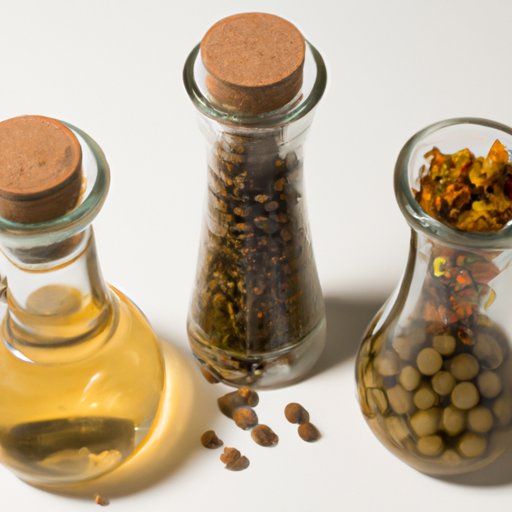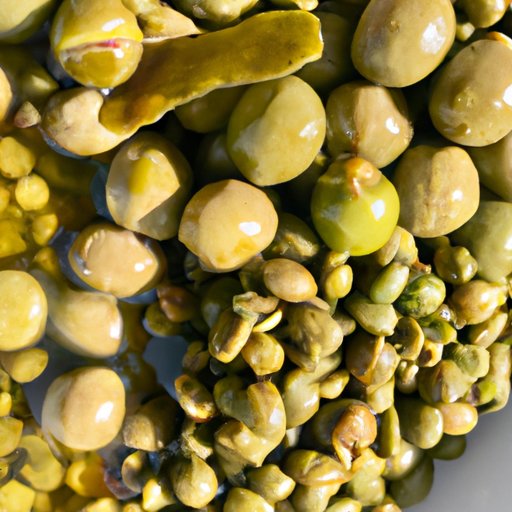Introduction
From Italian pasta dishes to American cocktails, the small but mighty caper has made its way into kitchens all around the world. Notorious for their sharp, briny taste and unique texture, capers are an ingredient that can pack a flavorful punch in a variety of dishes. In this comprehensive guide, we will explore the origin, culinary uses, health benefits and different methods of preserving capers. Additionally, we will examine how capers have influenced and been incorporated in different cuisines, and how one can utilize this versatile ingredient in their cooking.
Unlocking the Mystery of Capers: A Comprehensive Guide
Before we delve deeper into the world of capers, let us first look at its origins and how they are cultivated.
Origin and cultivation of capers
Capers are perennial plants that thrive in dry Mediterranean areas, such as Greece, Italy, and Spain. The caper bush, also known as Capparis spinosa, produces small unopened flower buds that are harvested before the leaves bloom. These buds are then preserved in brine or other methods to be used in various cuisines.
Culinary uses of capers, including traditional and modern dishes
Capers are a staple in many Mediterranean dishes, such as salads, pastas, and fish dishes. Their tart and tangy flavor make them an excellent addition to vinaigrettes and sauces, such as tartar sauce or hollandaise. Additionally, capers can be used as a garnish to add a pop of flavor to any dish. In modern cuisine, capers have become a key ingredient in dishes such as smoked salmon and caper pizza or caper fried chicken sandwiches, showcasing the versatility and range that capers can provide.
Variations of capers, such as caper berries and caper leaves
While capers themselves are small and often used in dishes as a garnish or addition to a recipe, caper berries are larger and can be eaten like olives. The caper berry has a similar taste to the caper, but with a milder flavor and a crunchier texture. Caper leaves, on the other hand, have a strong aroma and can be used in salads or cooked into dishes for added flavor.
Capers 101: How to Incorporate This Bold Ingredient Into Your Cooking
For those new to capers, here is a beginner’s guide to utilising the ingredient.
Beginner-level information on capers, including their taste and texture
Capers have a salty and sour taste, and their texture is slightly firm with a little crunch. The flavor depends on how the capers are preserved, so it is best to experiment to find what kind of caper suits your taste.
Suggestions for using capers in dishes such as salads, pasta sauces, and fish dishes
Capers pair well with a variety of dishes, but they are particularly suited for salads, pastas, and fish dishes. Adding capers to a Caesar salad or spaghetti Aglio e olio with anchovies and capers can provide a bold and noticeable kick. Capers also add brightness to fish dishes such as salmon or tuna, such as poached salmon with caper dressing.
Creative ideas for incorporating capers into unexpected dishes
Capers are not just for savory dishes. They also go well with desserts and cocktails. Make a lemon and caper sorbet as a refreshing palate cleanser, or add them to your gin and tonic for a briny twist. The possibilities are endless, and capers are waiting to be explored.
Small But Mighty: The Health Benefits of Capers
Not only do capers pack a powerful punch of flavor, but they are also loaded with nutrients and health benefits that make them worth incorporating into your diet.
Nutrient profile breakdown of capers, including vitamins and minerals
Capers contain antioxidants and are loaded with flavonoids such as quercetin. They also have a high concentration of vitamins and minerals, such as vitamin K, which is beneficial for bone health, and beneficial minerals like iron and magnesium.
Explanation of how capers’ properties can benefit health, such as their anti-inflammatory and antioxidant effects
The high concentration of antioxidants in capers makes them an excellent food for healthy aging. Additionally, capers have been shown to have anti-inflammatory effects, which can help reduce inflammation throughout the body and reduce the risk of chronic disease.
Cautions on consuming capers due to their high sodium content
It is important to note that capers are preserved in saltwater, and thus have a high concentration of sodium. It is recommended to consume capers in moderation, especially if you have high blood pressure or are following a low-sodium diet.
Going Beyond the Brine: Different Methods of Preserving Capers
Capers can be preserved in a variety of ways, each of which can provide a unique depth of flavor to your dish.
Different types of preserving capers such as salt curing and sun drying
There are several methods for preserving capers, including salt curing, sun-drying, and pickling in vinegar. Salt-cured capers tend to be stronger and spicier in flavor than those preserved in vinegar. Sun-dried capers are the least common method, but they have a unique smoky flavor that adds depth to dishes.
Explaining how each method affects the taste and texture of capers
As mentioned, preserving capers in different ways can affect their taste and texture. Salted capers tend to have a slightly firm texture, while those pickled in vinegar are softer. Sun-dried capers are crunchy and can have a more concentrated flavor. Experimenting with different methods can offer various new levels of flavor to your culinary favourites.
Recipe suggestions for dishes that highlight the taste differences between preservation methods
Try making a spaghetti puttanesca with salt-cured capers to maximize the bold flavor or try adding sun-dried capers to a tomato sauce for a smoky twist. The addition of a preserved ingredient can take the most basic dish to the next taste level.
Capers in Focus: How This Ingredient Impacted Different Cuisines
Capers have been used in Mediterranean cuisine for centuries but have also been incorporated into several other cultural dishes over time.
Exploration of how different cultures incorporate capers into their traditional dishes
India incorporates capers into their chutneys and pickles, while in France, capers are used extensively in traditional dishes such as steak tartare and Provencal ratatouille. In Jewish cuisine, capers are one of the key ingredients in lox and cream cheese.
Discussion on similarities and differences between cuisines’ approaches to using capers
Many cuisines use capers in a similar way, with capers in salads, pastas, and fish dishes being the most popular. However, there are always unique ways different cuisines experiment with capers to add their distinct touch. French cuisine, for example, features capers in steak tartare instead of ketchup like in traditional American cuisine.
Explanation of how capers have enriched global culinary culture
Capers, despite being a small ingredient, have had significant impacts on global cuisine. By being incorporated into various dishes all around the world, it unifies different cuisines and creates a global culinary culture.
From Seed to Table: A Journey Through the Life Cycle of a Caper
Understanding the journey of how capers go from growing to appearing in our favorite dishes can give us a closer connection to the ingredient and appreciation for it.
Description of growing and harvesting capers
Caper bushes thrive on rocky terrain and rough weather conditions. Caper plants are usually harvested from mid-May to August, as the flower buds grow to a particular size before being harvested.
Explanation of the process of turning capers into a culinary ingredient
The harvested capers are washed, placed into a brine solution, or other forms of preservation methods such as salt curing or pickling in vinegar and prepared for distribution to the market. The culinary ingredient-ready capers are then sorted by size and packaged in jars or cans to be distributed all around the world.
Discussion of the impact of quality and origin of capers on flavor and texture
The quality and origin of capers can significantly impact their flavor and texture. It’s why capers originating from different districts in Italy, Greece, and Spain often come with unique, distinct, and sought-after flavor characteristics. Cheaper canned versions do not always deliver the same distinct flavor as higher-grade preserved ones.

Capers and Beyond: Similar Ingredients to Experiment With
If you are a fan of capers, you might want to experiment with other ingredients that have a similar profile of tangy briney taste.
Explanation of other ingredients that have a similar briny-tangy flavor profile to capers
Olives and pickles are the natural choice for similarity in taste. Other ingredients include Anchovies, Sauerkraut, and seaweed. Even caper berries themselves, as mentioned earlier, a larger and milder version of capers, work well in place of olives with their similar flavor characteristics but unique texture and visual appeal.
Suggestions for how to combine capers with other ingredients for flavors that compliment and contrast
Capers pair perfectly with lemon, garlic, and herbs like oregano, thyme, and parsley. In contrast, combining it with ingredients such as honey or other sweet sauces can elevate your palate and create a unique balance between tart and sweet.
Recipe suggestions for dishes that play with briny ingredients
For a fun twist to a classic pizza, try using capers and anchovies instead of pepperoni or prosciutto. You can even combine capers and olive tapenade for a delicious briny appetizer. Try your hand at creating a beautifully balanced cheese board and incorporate some tart and tangy capers into the mix for a fuller taste.
Conclusion
Capers are a small but mighty ingredient extensively used in various culinary traditions all around the world. With its distinctive briny flavour and versatile uses, capers are an excellent addition to any kitchen. Whether you use them as a garnish or let them be the star of your dish, there is a caper recipe to satisfy any taste.
